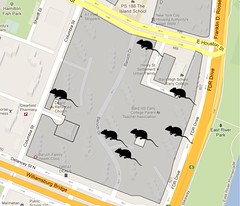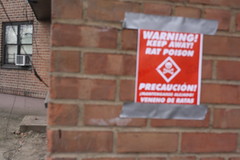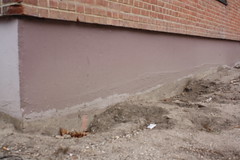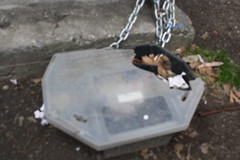They’ve been compared in size to squirrels, gophers, chihuahuas and cats. This much can be agreed upon: rats are a big problem at Baruch Houses, and residents plan to do so something about them.
“We shouldn’t have to live like this,” said a tenant of building 105. “The rats are like small cats. I’m definitely afraid of them.”
Some say the ongoing problem has gotten worse in the wake of Sandy, just as it has at Sara D. Roosevelt Park. They’re developing a plan to contain it before it get can get worse during the summer.
“It’s obvious that N.Y.C.H.A.’s Integrated Pest Management has failed,” said Jeanette Toomer in reference to the special unit that, according to the New York City Housing Authority, has been baiting the area since January. “If you see rats, it has failed,” said Ms. Toomer, a community organizer at Good Old Lower East Side who is helping residents draw up an alternate plan.
Last month, GOLES organized a “rodent walk-through” for city council members, representatives and public health officials. When the group examined a crawl space, “a rat the size of a chiuaua popped out,” Ms. Toomer said. Representatives from the offices of State Senators Daniel Squadron and Brad Hoylman, Assemblyman Brian Kavanagh, Councilwoman Rosie Mendez and Manhattan Borough President Scott Stringer attended the walk-through.
According to Ms. Toomer, residents have become wary of going outside at night, compromising the accessibility of the buildings.
“I’m not too afraid of them, but my mom is petrified,” said David Marcano, a resident of the complex just below East Houston Street.
After fielding at least one call a day about the rat problem, GOLES has identified seven “hot spots” for rodent activity, much of which occurs around unattended trash that “looks like breakfast, lunch and dinner” to hungry rats, Ms. Toomer said.
“At night it is incredible, how they just carouse and run around in front of the building,” said Carmen Negron, who has lived at Baruch Houses for 42 years. “The rats are bigger than the squirrels we have around here. They look very healthy, they are big and plump.”
Ms. Negron agrees that a big part of the problem is the accumulation of trash around the buildings. She started a petition requesting metal garbage bins with lids and brought the signatures she collected to an assistant at the housing authority, but “nothing was done with that, ever,” she said.
Baruch Houses does not have a recycling program, a factor that aggravates the rat problem, according to Ms. Negron and Ms. Toomer. Without recycling, residents of the complex combine their solid trash and food waste into one bin and leave it outside for pick-up. If the housing authority instituted a recycling program, the residents would be more likely to incinerate the organic waste and leave only the recyclables outside, limiting the rats’ food supply, Ms. Toomer said.
To make matters worse, there is a 36-hour window between garbage pick-up on Saturday afternoons and Monday mornings, Ms. Toomer said. During the summer, when it is hot and humid, the smell of trash becomes oppressive and draws the rats out of their burrows, according to a resident of building 80.
“They come out and tear up the garbage,” she said. “In the summertime you can’t sit on the benches, they are so bold.”
Ms. Negron echoed those concerns. “I imagine the summer is going to be worse, because we had Sandy. Some may have died, but now they are more aggressive.” She said that in the warmer months, the rats overrun the playground behind her building where she likes to take her grandchildren.
The New York City Housing Authority said in a statement that exterminators treat the grounds and basements at Baruch on a weekly basis. “Garbage is picked up daily by development staff and Sanitation collects the garbage three times a week,” the statement said. “N.Y.C.H.A. will continue to treat the area and educate residents on prevention, including the importance of proper garbage disposal.”
On a recent visit to the complex, The Local indeed observed several bait boxes, but residents complain that there are not enough and that the traps are checked irregularly.
“They don’t do it consistently. There is no continuity, so of course [the rats] come back and they breed,” said Ms. Negron. “And the quantity, the amount of rats doubles every time.”
The resident of building 80 offered a similar suggestion: “They need once-a-month inspections.”
Ms. Toomer agreed, and said that the plan organized by GOLES will likely include provisions for more regular baiting schedules and follow-ups. “It needs to be an ongoing process,” she said. With Baruch Houses under new management, she’s hopeful the problem can be fixed.
GOLES will host a meeting tomorrow for Baruch Houses residents to gather at their office and discuss the pest management plan.
Update | 7 p.m. Tomorrow’s meeting has been postponed to April 10 at 6:30 p.m.







